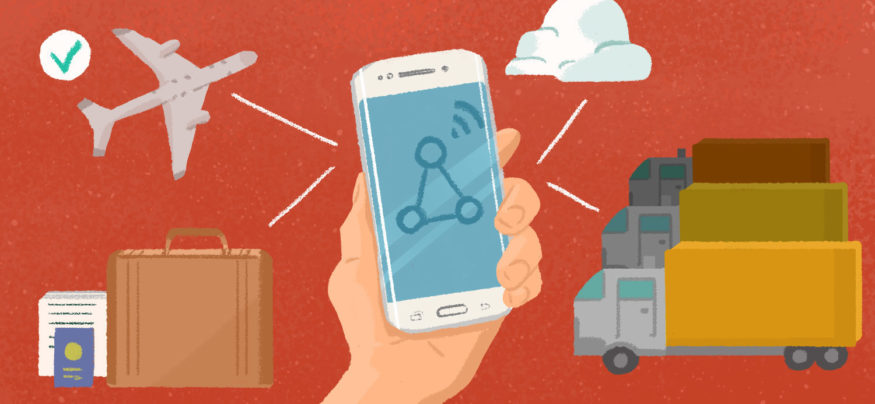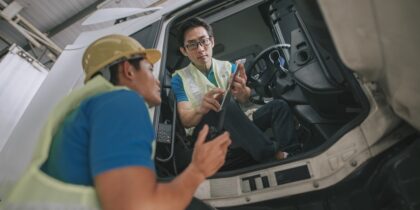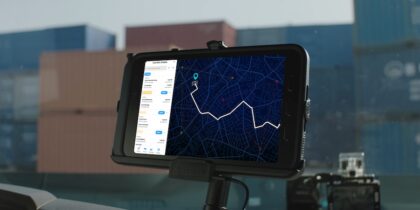Looking back at the growth of transportation technology in 2015, the penetration of smartphones and tablets into both the commercial and consumer markets is among the most notable telematics trends. From trucks to airlines to school buses, smartphones and tablets play a major role in enhancing the customer experience and disrupting transportation business models via fleet management and telematics.
Here’s a look back at the new transportation telematics trends we’ve tracked over the past year.
Mobile Devices Enhance Airline Productivity
Airlines are tapping into the power of mobility for ancillary revenue opportunities, maintenance improvements and flight crew training.
Airlines are using mobile devices to capture more than $50 billion in ancillary revenue a year, from seat upgrades, food and beverage purchases, in-flight entertainment, hotel and rental car bookings and other arrangements at the destination. Ancillary revenue can also mean more to an airline than boosting the bottom line. It can create a stronger bond with the consumer, generating repeat customers and free word-of-mouth marketing. Airlines can step up opportunities for in-air purchases using passengers’ own devices or onboard devices to capture a greater share of travelers’ budgets.
Some airlines have opted to give flight attendants tablets to handle onboard purchases. Using sleeves and card swipe accessories, airlines can implement an omnichannel approach to extend the shopping experience from the aircraft into airport shopping and destination activities.
Airlines constantly seek better ways to manage the maintenance, repair and overhaul processes for commercial aircraft. Failure to comply with maintenance regulations can lead to severe adverse consequences, as well as fines or the grounding of aircraft or even entire fleets. Many airlines have deployed MRO solutions using mobile devices such as smartphones and tablets to connect technicians on the ground with the enterprise for coordinated MRO management.
Mobile technology is transforming aviation in the cockpit, as well. Electronic flight bags have cut weight for fuel savings and made life easier for flight crews, who now only have to carry a tablet instead of a bag full of manuals.
Pilot training is undergoing a sea change, as well. With the help of computers, flight training devices and simulators, pilots spend months learning the fundamentals of flight before setting foot in an aircraft. Employees can access lessons, take tests and complete training from their mobile devices, and pilots and instructors have new ways in which to interact with one another. For example, pilots can share notes and create flash cards using applications on their tablets, and instructors can create websites or host video chats to cover specific material.
Passenger Connectivity Reveals Revenue Opportunities
As mobile device use continues to boom, transportation remains one of the last great frontiers for connectivity. Passengers on airlines, buses and trains have come to demand Wi-Fi without limits for the seamless connectivity they’ve come to expect in retail, hospitality and healthcare locations.
Transportation carriers can now communicate with passengers through every step of the journey, and passengers have access to connectivity for mobile devices. In-vehicle Wi-Fi that lets passengers connect to the digital ecosystem reveals opportunities for deeper service relationships and revenue opportunities.
Airline passengers also show a voracious appetite for connectivity, and 97 percent of airline passengers board with some form of personal electronic device. Wireless-enabled in-flight entertainment has expanded from seat-back devices to embrace mobile devices to feed passengers’ desire for entertainment, flight information, and food and beverage options at their fingertips.
On buses and trains, passengers can make trip-related purchases on their devices, while the driver may use a tablet for routing, and digital signage can be managed remotely. Passengers can be connected either through fee-based usage or via advertising-supported networks such as in the New York City subway system. Onboard Wi-Fi also boosts opportunities for geolocation marketing, allowing advertisers to promote businesses near bus or train routes.
Trucks Get Smarter and More Connected
Transportation companies have turned to fleet management to drive efficiency. Telematics solutions allow fleet administrators to easily streamline communications, report progress in real time, track compliance with federal regulations and enhance security.
Existing equipment can send data to one central access point. GPS devices, laptops, tablets and smartphones are all telematic devices due to their data collection and communication capabilities.
With mobile devices and fleet management apps, trucking operations personnel can communicate with drivers on the road, uploading everything from permits and manuals to checklists and routes. Using telematics technology to track, store and analyze driver and vehicle data, fleet managers are able to improve fuel economy and emissions by giving feedback on driving technique. Similar to insurer-installed consumer black boxes, mobile trucking intelligence platforms can detect when drivers are pressing the brakes too hard, shifting gears improperly or keeping trucks idle for too long.
Other fleet management solutions that were popular over the past year include electronic logging devices that allow trucking organizations to move these paper-based processes into electronic formats, saving time for drivers and management. Through this technology, companies can identify and correct wasteful behavior to comply with evolving government regulations.
The growth of telematics trends this year extended from commercial to consumer markets. From fleet to education, smartphones and tablets played a major role in enhancing the customer experience and disrupting transportation business models for the better.








